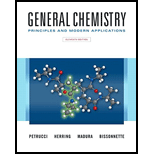
Interpretation:
Major product of the given reaction is to be determined. Also, the mechanism for each reaction should be described.
Concept introduction:
Nucleophilic substitution reaction
Elimination reaction is the type of reaction in which two substituents attached to the adjacent carbon atoms are removed from the reactant molecule to form the product. In
Want to see the full answer?
Check out a sample textbook solution
Chapter 27 Solutions
Generl Chem Looself&mod Mst/et&stdy Crd Pkg, 11/e
- Aldehydes and ketones react with thiols to yield thioacetals just as they react with alcohols to yield acetals. Predict the product of the following reaction, and propose a mechanism:arrow_forwardPredict the products of the following elimination reaction and indicate which is the major product:arrow_forwardSynthesis. Supply the reagents required to accomplis the following syntheses. Indicate the relative stereochemistry, where applicable, of the products obtained at each step.arrow_forward
- When 2-methylpent-2-eno reacts with HCl two alkyl halides are formed. Present the structures of the formed products and propose a mechanism that explains the formation of these products. Indicate the main product.arrow_forwardThe reaction of bromo methylcyclopentane in methanol and heat, generates a complex mixture of products and consisting of the following five compounds. Propose mechanisms that explain these productsarrow_forwardEstablish the reagents necessary to carry out the following synthesis, also propose a reasonable reaction mechanism for the formation of the product.arrow_forward
- Give the process of Determining the Mechanism and Stereochemistry inNucleophilic Substitution ?arrow_forwardEnamines normally react with methyl iodide to give two products: one arising from alkylation at nitrogen and the second arising from alkylation at carbon. For example, Heating the mixture of C-alkylation and N-alkylation products gives only the product from C-alkylation. Propose a mechanism for this isomerization.arrow_forwardIt is not uncommon for organic chemists to prepare acetals by an exchange-type process known as transacetalization. Predict the product(s) and show the mechanism for the transacetalization reactions below.arrow_forward
- Following are the steps in the industrial synthesis of glycerin. Provide structures for all intermediate compounds (AD) and describe the type of mechanism by which each is formed.arrow_forwardA problem often encountered in the oxidation of primary alcohols to acids is that esters are sometimes produced as by-products. For example, oxidation of ethanol yields acetic acid and ethyl acetate: Propose a mechanism to account for the formation of ethyl acetate. Take into account the reversible reaction between aldehydes and alcohols:arrow_forwardBenzyl bromide is converted into benzaldehyde by heating in dimethyl sulfoxide. Propose a structure for the intermediate, and show the mechanisms of the two steps in the reaction.arrow_forward

 Organic ChemistryChemistryISBN:9781305580350Author:William H. Brown, Brent L. Iverson, Eric Anslyn, Christopher S. FootePublisher:Cengage Learning
Organic ChemistryChemistryISBN:9781305580350Author:William H. Brown, Brent L. Iverson, Eric Anslyn, Christopher S. FootePublisher:Cengage Learning EBK A SMALL SCALE APPROACH TO ORGANIC LChemistryISBN:9781305446021Author:LampmanPublisher:CENGAGE LEARNING - CONSIGNMENT
EBK A SMALL SCALE APPROACH TO ORGANIC LChemistryISBN:9781305446021Author:LampmanPublisher:CENGAGE LEARNING - CONSIGNMENT


